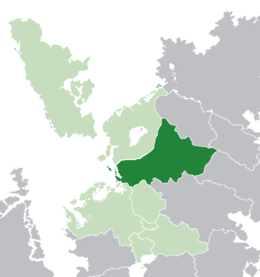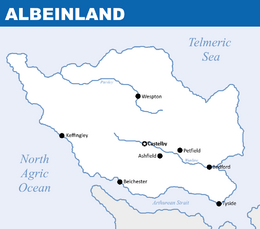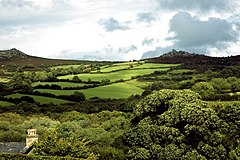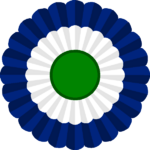Albeinland: Difference between revisions
m (→Biodiversity: Fixed wiki links and grammar) |
No edit summary |
||
| Line 74: | Line 74: | ||
|image_map3 = | |image_map3 = | ||
}} | }} | ||
'''Albeinland''', officially the '''Kingdom of Albeinland''' | '''Albeinland''', officially the '''Kingdom of Albeinland''', is a sovereign state in west [[Lorecia]], sharing borders with [[Noordenstaat]] and [[Fyngaria]] to the south, Arstotska and [[Aswick]] to the northeast and [[Aurora Confederacy]] to the northwest. Its geographical location comprises of the Alban Highlands on the mainland and the islands of Arsey, Brenswick, Brunhill and Lanwel on the Albish Channel. The country has an estimated population of 30 million inhabitants, most of them living in urban spaces such as the capital and largest city, Castelby. Albeinland is a member of the World Assembly since 1991 and is one of the founding states of the [[Lorecian Community]] in 1994. | ||
The area that now encompasses Albeinland was settled by [[Arlethic peoples|Alerthian tribes]], an ethnolinguistic group who is conductive to several modern peoples in Lorecia from the 1st century BCE to the 6th century CE. The first Christian missionaries arrived in the 5th century CE and established several churches and monasteries, with local natives and its tribes developing and founding the Kingdom of Anglea, the Kingdom of Cambria and the Duchy of Lencester in the early 7th century. In 1016, after many wars and conflicts, the House of Annesley of Anglea rose to unify the Alban Highlands, with Arthur of Anglea becoming the first sovereign of an united Albeinland. The middle ages were a scene of military conquests which consolidated the Albish state. | |||
Although the massive | Although the creation of a legislative body in the 14th century, the massive authority of the sovereign and the little jurisdiction of the Parliament created the first clashes between the two powers who only worsened over the years. Most of the Albish population converted to {{wp|Protestanism}} in the 16th century, giving to the monarch more powers over the Parliament with the creation of the Church of Albeinland. The final spark was made in 1663 when the Albish Revolution started and divided the nation between absolutists and constitutionalists, ending the war with a rebel victory and the introduction of a constitutional monarchy in the country. The 18th century was a golden age for national politics, economy and philosophy while the 18th century witnessed the introduction of modern democracy, with {{wp|Universal manhood suffrage|universal male suffrage}} being enacted in 1872 and {{wp|Women's suffrage|women's suffrage}} in 1919. | ||
Today, Albeinland is a {{wp| | Today, Albeinland is a {{wp|developed country}} with a high IDH and life quality operating under a constitutional parliamentary monarchy, with Catherine II acting as monarch and Vincent Lloyd as Chancellor. The country is a member state of the [[Lorecian Community]] and the World Assembly. | ||
==Etymology== | ==Etymology== | ||
Revision as of 18:09, 17 March 2019
Kingdom of Albeinland | |
|---|---|
| Motto: Libertas quæ sera tamen "Liberty albeit late" | |
| Anthem: Albish National Anthem | |
 Albeinland (dark green) in Lorecian Community (light green) | |
 Political map of Albeinland | |
| Capital and largest city | Castelby |
| Official languages | English |
| Ethnic groups (2018) |
|
| Demonym(s) |
|
| Government | Unitary parliamentary constitutional monarchy |
• Monarch | Catherine II |
• Chancellor | Vincent Lloyd |
| Legislature | Parliament |
| House of Commons | |
| House of Lords | |
| Establishment | |
• Foundation of Castelby | 5th century AD |
• Unification | 12 December 1016 |
• Oxford Revolution | 16 August 1652 |
| Area | |
• Total | 1,291,800 km2 (498,800 sq mi) |
| Population | |
• 2019 estimate | 30,969,622 |
• 2018 census | 30,968,221 |
• Density | 23/km2 (59.6/sq mi) |
| GDP (PPP) | 2018 estimate |
• Total | £4.028 trillion |
• Per capita | £29,072 |
| GDP (nominal) | 2018 estimate |
• Total | £5.109 trillion |
• Per capita | £34,011 |
| Gini (2018) | low |
| HDI (2018) | very high |
| Currency | Sterling (£) |
| Time zone | UTC+1 (UTC) |
| Date format | dd-mm-yyyy |
| Driving side | left |
| Calling code | +36 |
Albeinland, officially the Kingdom of Albeinland, is a sovereign state in west Lorecia, sharing borders with Noordenstaat and Fyngaria to the south, Arstotska and Aswick to the northeast and Aurora Confederacy to the northwest. Its geographical location comprises of the Alban Highlands on the mainland and the islands of Arsey, Brenswick, Brunhill and Lanwel on the Albish Channel. The country has an estimated population of 30 million inhabitants, most of them living in urban spaces such as the capital and largest city, Castelby. Albeinland is a member of the World Assembly since 1991 and is one of the founding states of the Lorecian Community in 1994.
The area that now encompasses Albeinland was settled by Alerthian tribes, an ethnolinguistic group who is conductive to several modern peoples in Lorecia from the 1st century BCE to the 6th century CE. The first Christian missionaries arrived in the 5th century CE and established several churches and monasteries, with local natives and its tribes developing and founding the Kingdom of Anglea, the Kingdom of Cambria and the Duchy of Lencester in the early 7th century. In 1016, after many wars and conflicts, the House of Annesley of Anglea rose to unify the Alban Highlands, with Arthur of Anglea becoming the first sovereign of an united Albeinland. The middle ages were a scene of military conquests which consolidated the Albish state.
Although the creation of a legislative body in the 14th century, the massive authority of the sovereign and the little jurisdiction of the Parliament created the first clashes between the two powers who only worsened over the years. Most of the Albish population converted to Protestanism in the 16th century, giving to the monarch more powers over the Parliament with the creation of the Church of Albeinland. The final spark was made in 1663 when the Albish Revolution started and divided the nation between absolutists and constitutionalists, ending the war with a rebel victory and the introduction of a constitutional monarchy in the country. The 18th century was a golden age for national politics, economy and philosophy while the 18th century witnessed the introduction of modern democracy, with universal male suffrage being enacted in 1872 and women's suffrage in 1919.
Today, Albeinland is a developed country with a high IDH and life quality operating under a constitutional parliamentary monarchy, with Catherine II acting as monarch and Vincent Lloyd as Chancellor. The country is a member state of the Lorecian Community and the World Assembly.
Etymology
The origin of the name Albeinland doesn't have a proven and unique origin, since its geographical position facilitated that diverse tribes coming from Aurora Confederacy crossed or established temporary settlements on several occasions before the 1st century BCE, which culminated in different names for the same region. The most likely and acceptable theory by etymologists is that Albeinland comes from the Old English Albaland, meaning "land of the Albans". The Albans are considered one of the predecessors of the current Albish people who had direct descent from the Arlethians, an ethno-linguistic group which also are the ancestors of several other modern peoples in Lorecia and Astyria.
It is not well known where the term was exactly created, but chronicles dating from the 6th century CE by Christian monasteries already used the name Albalonde in their writings. The origin of the term Alba still pretty unknown, meaning white in several languages and then probably referring to the white from snow in the long winters, which are traditional due the local climate. So, it's reasonable to say that the term had a geographical and climatic origin, with local tribes beginning to call themselves as Albans soon after to distance themselves from Arlethian terms in the christianization of the region and the founding of the first Albish kingdoms, since such terms were classified as pagan.
The first use of Albeinland happened in 1466, being a modern anglicisation of the old term. Previously, in the Arlethian occupation between the 1st century BCE and 7th century CE, the term Albalanda was used, meaning white earth or white land. The terms Alba or Albion and their demonym Albian are not classified as wrong neither by the Government and Parliament, but being more used poetically.
History
Geography
Albeinland, with a total area of 1,291,800 square kilometres, includes the region known as the Alban Highlands as well as the islands of Arsey, Brenswick, Brunhill and Lanwell on the Albish Channel. Much of the continental Albish landscape comprises plateaus or mountainous regions such as the Apperlane Mountains in southwest Cambria, bordering Noordenstaat, Fyngaria, Aswick and Artotska. Albeinland has five mountains with peaks over 1,000 metres, with the Effing Pike being the highest at 4,018 metres.
The several small mountains and plateaus in the central region up to the coastline ranges from two hundred to four hundred metres in altitude, with Castelby being two hundred and fifty metres above sea level while Eidenburgh and Bedford at three hundred metres above sea level. Despite being at relatively high altitudes for Lorecia, the Albish terrain is not particularly rough, supporting the defence of major cities in mediaeval times and not negatively affecting to a great extext agriculture in the region. According to the latest geographical census, 23% of the Albish territory consists of forested areas, while 44% is used for agriculture and 12% for pasture.
The main rivers in Albeinland are the Kensingley, Ossey and Hammerworth, all of them rising in the Apperlane Mountains and flowing into the Albish Channel. The three rivers and their tributaries are crucial for maintaining the agriculture and industry in Lencester as well as supplying water to the biggest cities of Albeinland. Most of the Albish lakes are located in the province of Bedfordshire in a region known as Lake Lands. The most important lakes are Lake Victoria and Lake Everest, near the Aswickan border.
Climate

Albeinland is considered one of the coldest countries in Lorecia, with an average temperature varying between -2°C to -15°C in the winters and 5°C to 18°C in the summers. The coldest months are December and January, while June and July are the hottest. According to the Köppen climate classification, about 40% of the Albish territory has a cool temperate climate with stiffer winters and mild summers, with cities such as Castelby, Bedford, Eidenburgh and Rosefort suffering snowstorms in the winters and having a cool climate in the summers followed by a transitional humid continental climate between the coastline and countryside. The Albish coast has an oceanic climate with mild winters and warmer summers.
In the more mountainous regions located near the borders, the tundra biome predominates, with the temperature remaining below zero almost all year. Since the Alverville Observatory began to record the weather, the highest temperature ever recorded was 37°C on August 2007 in Hampsey and the coldest temperature being -41°C in Pendston on March 1994.
Biodiversity
The fauna and flora of Albeinland shares many species in common with other Lorecian countries; however, it has a number of unique animals and plants. There is a large number of oaks and pines in its forested areas, with oaks being distributed more in the coastal and central zones with the pines in the colder regions. In terms of fauna, the country has a series of small and medium-sized birds and mammals such as Arseyan wrens, red squirrels, foxes and ferrets.







